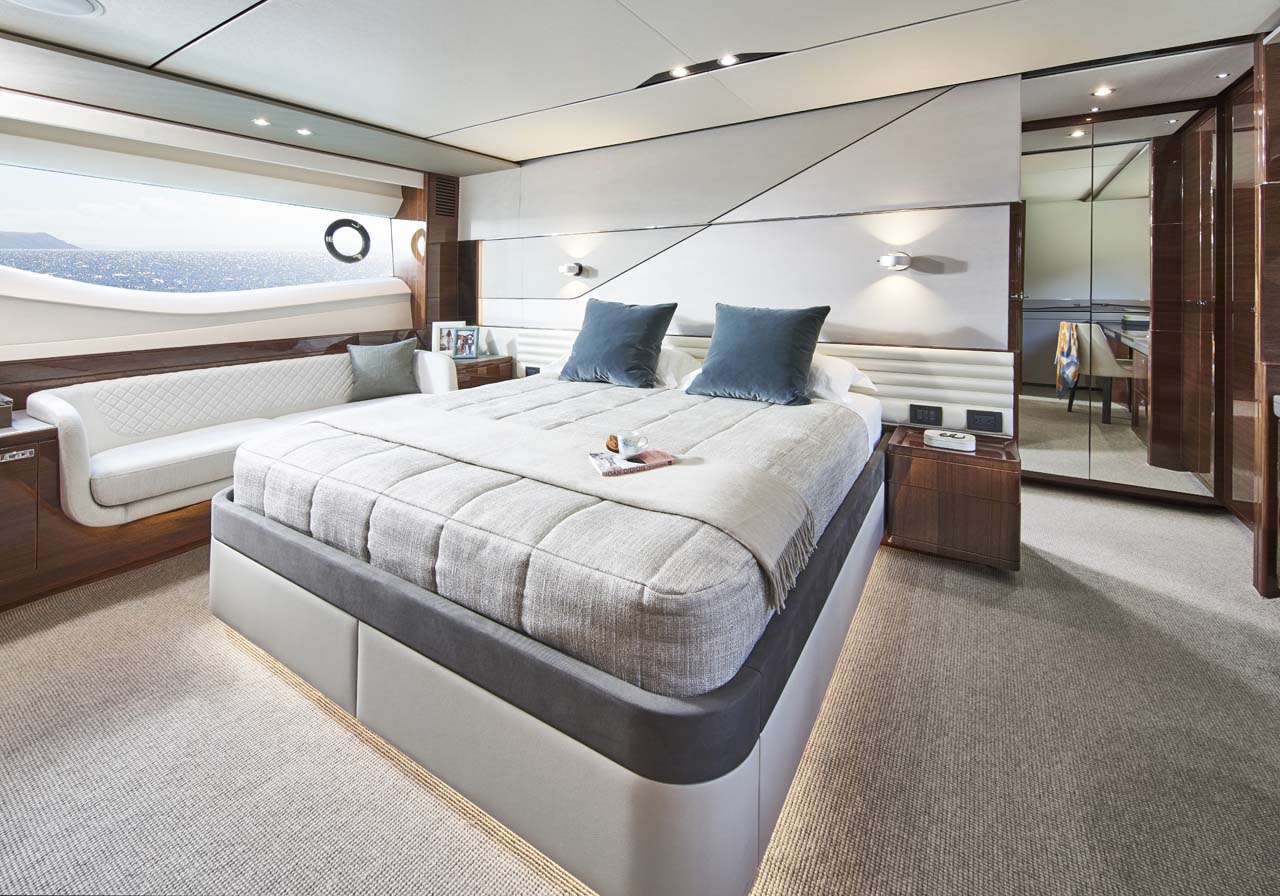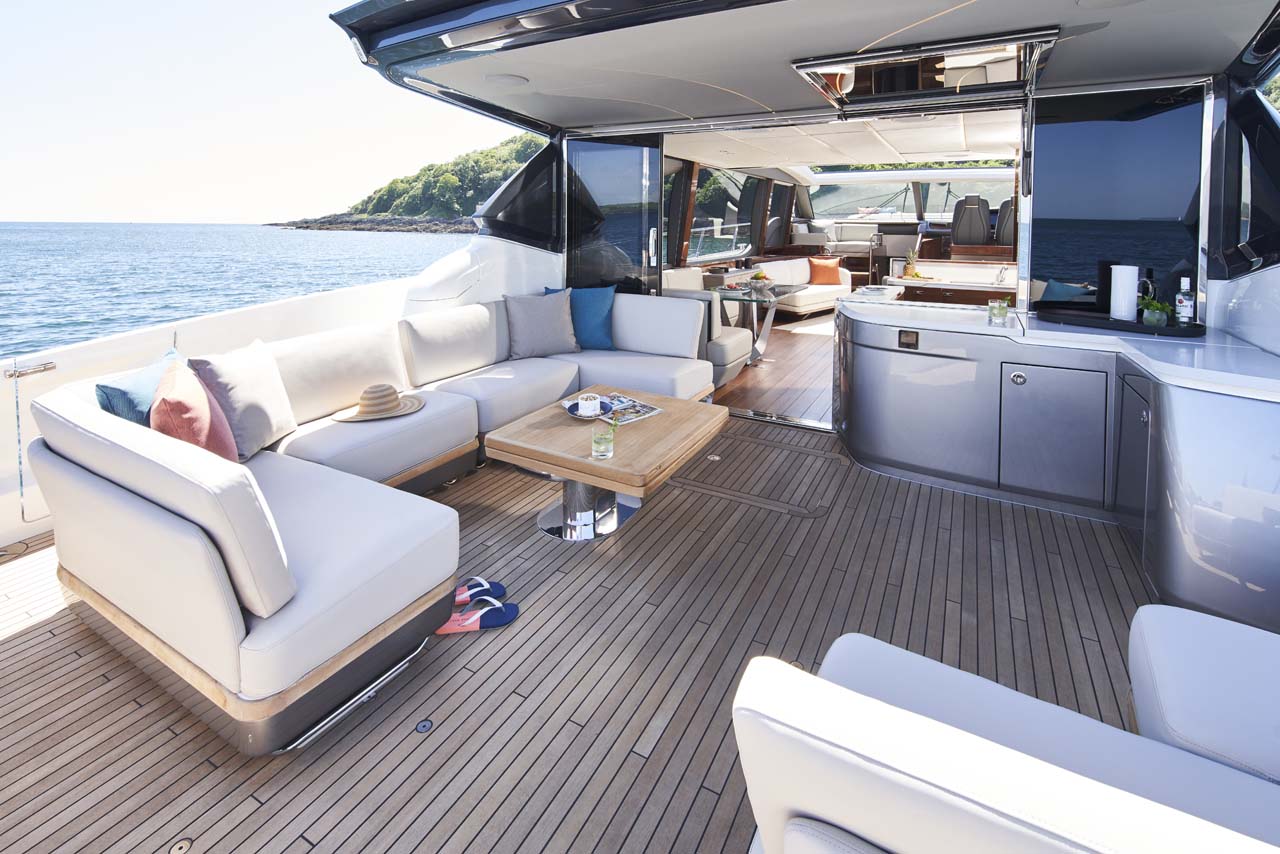THE STANDARD BEARER OF PRINCESS YACHTS’ SPORT LINE, THE V78 IS A FLOATING CONDOMINIUM, YET CAN OUTRUN ENTHUSIAST VESSELS HALF ITS SIZE
BY EVAN MONROE
According to the National Marine Manufacturers Association, there were an estimated 13 million registered boats in the U.S. in 2018 (the last year for which figures were tabulated by the NMMA). In that same year, the marine products and services industries totaled just under $40 billion, and produced an overall economic impact of more than $130 billion (including direct, indirect, and multiplier spending on nearby restaurants, retail, etc.), supporting nearly 700,000 U.S. jobs. In terms of new sales, one of the biggest upward trends was towards yachts and large cruising boats, a sector that lagged behind small vessel sales in their percentage increases from 2009 to 2015.

With an eye towards that burgeoning market, Princess Yachts a 54 year old Plymouth, UK based maker has been steadily broadening its 50 foot and up fleet over the last decade to include Flybridge, S Class sport bridge, and V Class motor yachts, with one of the latest in the last category, the Princess V78, seen here.
Just over 80 feet in length overall (including pulpit), an inch shy of 19 feet in beam, and weighing 50.6 tons, the V78 falls somewhere between very generously sized and superyacht, a class that’s attractive for a number of reasons, not least that it can be minimally crewed and berthed at most recreational marinas. What’s truly remarkable for a vessel of this size, however, is its performance. With twin MAN V12 diesel engines producing a total of 3,800 marine horsepower, the Princess’s top speed is an astonishing 39 knots (just under 45 mph), more than fast enough to tow multiple skiers while outrunning a nuclear aircraft carrier. Other than pure cylinder brawn, the principal reason for that astonishing statistic is the deep V resin infused hull, which optimizes lift while minimizing drag tweaked for ingenious use of interior space yet somehow remaining steady, even in high seas.

The main entryway is via the transom, illuminated by a Princess “crown” logo. Just a few steps away is a cockpit featuring flexible modular seating and a dining area with folding teak table. Further forward is a galley kitchen, its features including granite/quartz worktops, four zone induction cooktop, extractor fan, and microwave/convection oven with grill. If the crew is preparing meals, it’s possible to screen off the galley using a powered room divider.
The main deck saloon offers seating that includes an angled port side sofa, as well as a sideboard unit for bottle and glass storage and a bar refrigerator, plus a motorized (for concealment) UHD LED TV with DVD/Blu-ray and Naim Audio system. Perhaps most remarkable of all, this living space can be exposed to the elements at a touch of a button, as its entire roof can be retracted.

There is accommodation for a total of ten; four en suite cabins offering berths for eight, plus two in the master. The master stateroom presents a large double bed, a 40 inch TV (with dedicated audio system), plus ample storage for extended stays at sea. A separate lobby features a washer dryer and laundry facilities, and a further aft twin cabin is available for occasional guests or crew.
Topside, an expansive foredeck features Princess designed “sunpads” that can be converted into aft facing seats. The stern also houses a garage and integrated launch system that can comfortably accommodate a 15 foot tender. Featuring an electro hydraulic door, the launch platform is also a perfect base for watersports. A separate and watertight door in the transom gives direct access to the crew cabin and engine room.

Under the watchful eye of Sarah Verey, Princess Yachts’ director of creative design, particular attention was paid to transitions between exterior and interior deck spaces. The flowing lines of the cockpit headliner panels, for example, dovetail into the saloon complemented by a continuation of both design and paint finish from cockpit to galley.
“Our design brief was to focus on a seamless visual and physical transition between indoor and outdoor spaces,” said Verey. “The use of beautiful, textured surface finishes complements the purity of the hull design. Form and function combine here, as always, to reinforce V Class traditions of luxury, style, and speed in equal measure.”
Exterior living spaces are highlighted by upholstery with hand stitched contrast detailing, hand laid directional veneers, and soft angled furniture, plus recessed “fashion lines” through the internal bulkheads and headlining and a hand stitched helm seat.

A novel perk of ownership is a two year membership in Princess Lifeline, a unique 24/7 international “SOS service” in partnership with MedAire, providing around the clock global access to medical and travel safety experts and transport. According to the maker, such a service has never before been included as part of a new yacht purchase.
Oyster Harbors Marine, Inc.
33 Pratt Street, Essex, CT 860.581.8067 / oysterharborsmarine.com
LIVING ON BOARD
Technically, living aboard a vessel in New York City is verboten. That said, hundreds make them year round residences, though entertain a certain degree of risk in doing so (and what seafaring soul does not?). Marinas offering “wet winter storage” and which accept “frequent stay aboards” are great places to start. Boat dwellers will still need a separate permanent address (such as a P.O. box) for legal and tax purposes, as well as a place to go in the event of a weather or other vessel emergency. And, of course, these extra legal domiciles don’t feature the residency rights associated with a rented or purchased home.
Technically, living aboard a vessel in New York City is verboten. That said, hundreds make them year round residences, though entertain a certain degree of risk in doing so (and what seafaring soul does not?). Marinas offering “wet winter storage” and which accept “frequent stay aboards” are great places to start. Boat dwellers will still need a separate permanent address (such as a P.O. box) for legal and tax purposes, as well as a place to go in the event of a weather or other vessel emergency. And, of course, these extra legal domiciles don’t feature the residency rights associated with a rented or purchased home.

Those expecting the experience to be an exercise in rent busting thrift are often disappointed, however. Slip leases are based on vessel length, and vary by season. In the winter in NYC, they start at about $70 per foot per month (in summer, plan on doubling that), often with utilities not included. So, for a 30 foot cabin cruiser, the low end would average $3,000 per month. Garden State prices are typically one third less than that.
